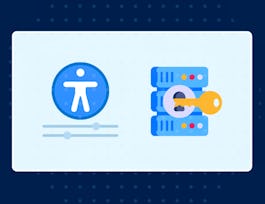Course 2 teaches you how to distinguish between different methods for studying human error. You will also learn about human-centered design and usability, and how to compare and contrast different methodologies for evaluating the usability of products, technologies & systems.



How Can We Measure and Study Human Error?
This course is part of Human Factors & Usability Engineering: Designing for Humans Specialization

Instructor: Robert Gray
Sponsored by IEM UEM Group
Recommended experience
What you'll learn
Learn how to distinguish methods for studying human error and analyze methodologies for evaluating the usability of products, technologies & systems.
Details to know

Add to your LinkedIn profile
4 assignments
See how employees at top companies are mastering in-demand skills

Build your subject-matter expertise
- Learn new concepts from industry experts
- Gain a foundational understanding of a subject or tool
- Develop job-relevant skills with hands-on projects
- Earn a shareable career certificate


Earn a career certificate
Add this credential to your LinkedIn profile, resume, or CV
Share it on social media and in your performance review

There are 5 modules in this course
In this course, you will gain the skills to distinguish between various research methods, understand their strengths and weaknesses, and explore human-centered design principles. By the end of Course 2, you will be well-equipped to conduct comprehensive research and evaluation to optimize human interactions within complex systems.
What's included
1 video1 reading
In this module, we will explore the fundamental concepts and methods used in research and evaluation. We will begin by examining various research methods for studying human performance and human error. We will then delve into the process of hypothesis testing and the key elements of a research study or experiment. Additionally, we will discuss the effects that need to be accounted for, such as confounding variables, placebo effect, and framing. By the end of this module, you will have a solid foundation in research methods and hypothesis testing, enabling you to design and conduct effective studies in the field of human factors.
What's included
3 videos4 readings1 assignment
In this module, we will continue our exploration of different methods for studying human error. Building upon the foundational knowledge from Module 1, we will delve deeper into advanced techniques and approaches used to analyze and understand human errors in various domains. By examining case studies, research papers, and expert insights, you will enhance your understanding of the complexities involved in studying human error and develop a comprehensive toolkit of research methods.
What's included
3 videos6 readings1 assignment
This module provides an overview of usability and human-centered design. It explores key components of usability, such as learnability, efficiency, memorability, errors, and satisfaction. The module also covers the concept of affordances and their impact on user interactions. Additionally, learners gain insights into human-centered design principles, including empathy mapping and the iterative design process.
What's included
3 videos6 readings1 assignment1 discussion prompt
In Module 4, we delve into the methods for evaluating usability, focusing on usability research and methodology. We explore how to assess the usability of products and technology in various domains and examine the findings from research conducted in these areas.
What's included
3 videos8 readings1 assignment
Instructor

Offered by
Why people choose Coursera for their career




Recommended if you're interested in Physical Science and Engineering

New York University

Board Infinity

University of Amsterdam

University of Michigan

Open new doors with Coursera Plus
Unlimited access to 10,000+ world-class courses, hands-on projects, and job-ready certificate programs - all included in your subscription
Advance your career with an online degree
Earn a degree from world-class universities - 100% online
Join over 3,400 global companies that choose Coursera for Business
Upskill your employees to excel in the digital economy


